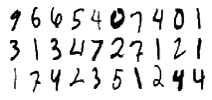rxNeuralNet vs. xgBoost vs. H2O
Want to share your content on R-bloggers? click here if you have a blog, or here if you don't.
Recently, I did a session at local user group in Ljubljana, Slovenija, where I introduced the new algorithms that are available with MicrosoftML package for Microsoft R Server 9.0.3.
For dataset, I have used two from (still currently) running sessions from Kaggle. In the last part, I did image detection and prediction of MNIST dataset and compared the performance and accuracy between.
MNIST Handwritten digit database is available here.

Starting off with rxNeuralNet, we have to build a NET# model or Neural network to work it’s way.
Model for Neural network:
const { T = true; F = false; }
input Picture [28, 28];
hidden C1 [5 * 13^2]
from Picture convolve {
InputShape = [28, 28];
UpperPad = [ 1, 1];
KernelShape = [ 5, 5];
Stride = [ 2, 2];
MapCount = 5;
}
hidden C2 [50, 5, 5]
from C1 convolve {
InputShape = [ 5, 13, 13];
KernelShape = [ 1, 5, 5];
Stride = [ 1, 2, 2];
Sharing = [ F, T, T];
MapCount = 10;
}
hidden H3 [100]
from C2 all;
// Output layer definition.
output Result [10]
from H3 all;
Once we have this, we can work out with rxNeuralNet algorithm:
model_DNN_GPU <- rxNeuralNet(label ~. ,data = dataTrain ,type = "multi" ,numIterations = 10 ,normalize = "no" #,acceleration = "gpu" #enable this if you have CUDA driver ,miniBatchSize = 64 #set to 1 else set to 64 if you have CUDA driver problem ,netDefinition = netDefinition ,optimizer = sgd(learningRate = 0.1, lRateRedRatio = 0.9, lRateRedFreq = 10) )
Then do the prediction and calculate accuracy matrix:
DNN_GPU_score <- rxPredict(model_DNN_GPU, dataTest, extraVarsToWrite = "label") sum(Score_DNN$Label == DNN_GPU_score$PredictedLabel)/dim(DNN_GPU_score)[1]
Accuracy for this model is:
[1] 0.9789
When working with H2O package, the following code was executed to get same paramethers for Neural network:
model_h20 <- h2o.deeplearning(x = 2:785 ,y = 1 # label for label ,training_frame = train_h2o ,activation = "RectifierWithDropout" ,input_dropout_ratio = 0.2 # % of inputs dropout ,hidden_dropout_ratios = c(0.5,0.5) # % for nodes dropout ,balance_classes = TRUE ,hidden = c(50,100,100) ,momentum_stable = 0.99 ,nesterov_accelerated_gradient = T # use it for speed ,epochs = 15)
When results of test dataset against the learned model is executed:
h2o.confusionMatrix(model_h20) 100-(416/9978)*100
the result is confusion matrix for accuracy of predicted values with value of:
# [1] 95.83083
For comparison, I have added xgBoost (eXtrem Gradient Boosting), but this time, I will not focus on this one.
Time comparison against the packages (in seconds), from left to right are: H20, MicrosoftML with GPU acceleration, MicrosoftML without GPU acceleration and xgBoost.

As for the accuracy of the trained model, here are results (based on my tests):
MicrosoftML – Neural Network – 97,8%
H20 – Deep Learning – 95,3 %
xgBoost – 94,9 %
As always, code and dataset are available at GitHub.
Happy R-ing 
R-bloggers.com offers daily e-mail updates about R news and tutorials about learning R and many other topics. Click here if you're looking to post or find an R/data-science job.
Want to share your content on R-bloggers? click here if you have a blog, or here if you don't.
